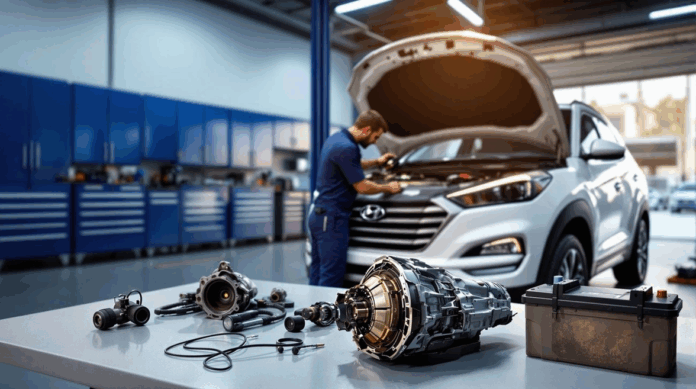Hyundai’s problems in UAE might catch you off guard, given that it’s one of the world’s top five largest automakers. The brand offers a solid 10-year, 100,000-mile warranty. Repair costs average $468 per year, which is $200 less than other brands, but UAE owners have reported several ongoing issues.
Hyundai ranks seventh among 33 brands in J.D. Power’s U.S. Vehicle Dependability Study. Yet its common problems need attention. The biggest issues include engine crankshaft position sensor failures, transmission problems, and electrical system malfunctions. The Theta II engine models face issues like knocking, seizing, and sludge buildup. Some models have dangerous ABS system short-circuits that could start fires. Hyundai vehicles typically last around 200,000 miles, matching other mainstream manufacturers. Models like the Accent struggle with high oil consumption, engine misfires, and rough idling.
This piece will get into the 13 most common Hyundai problems based on UAE owner experiences for 2025. You’ll learn what to watch for before buying or to help fix issues with your current vehicle.
Engine Crankshaft Sensor Failure
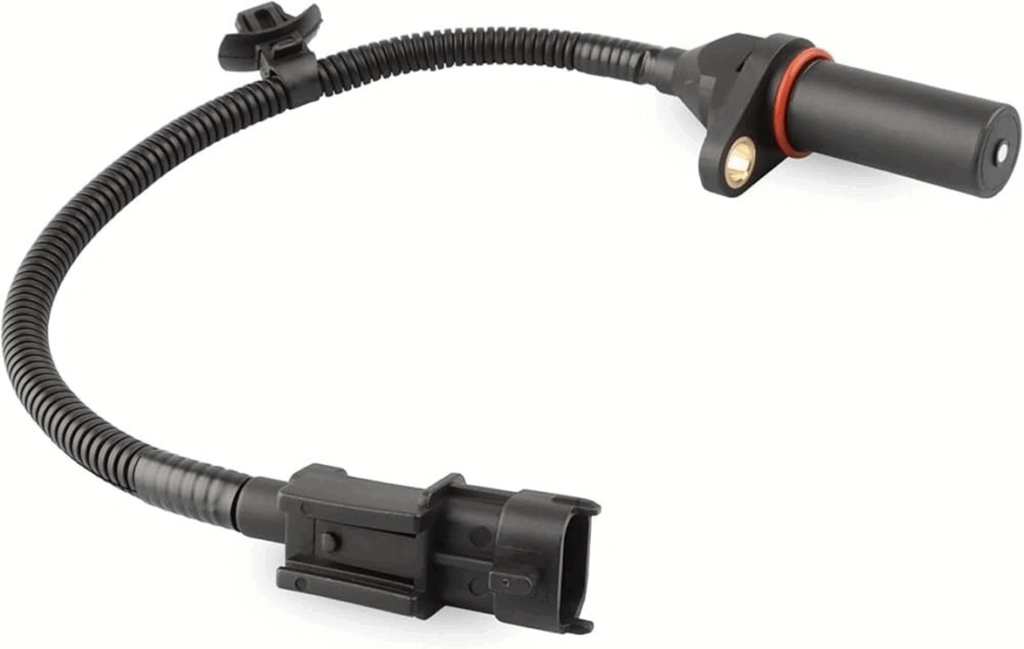
“Hyundai is known for building durable vehicles, and the Santa Fe is no exception.” — YallaMotor Editorial Team, Automotive publication specializing in Middle Eastern car market analysis
A crankshaft position sensor looks tiny, yet it causes some of the biggest headaches for Hyundai drivers in the UAE. This small part does a big job in your vehicle’s operation. The impact of its failure goes way beyond what its size might suggest.
Problem overview
Your engine’s computer system relies on the crankshaft position sensor to track the rotating crankshaft’s position and speed. A failing sensor shows several warning signs. Your Hyundai might struggle to start, stall without warning, display a check engine light, accelerate poorly, and burn more fuel. The problems get worse in wet weather. Cars might slow down substantially, lose their tachometer readings, and barely reach 35-40 km/h.
The sensor can fail without showing any diagnostic trouble codes at first, which makes it hard to pinpoint the issue. Later on, you’ll see P0335 (Crankshaft Position Sensor A Circuit Malfunction) and P0336 (Crankshaft Position Sensor A Circuit Range/Performance) codes pop up.
Affected Hyundai models
Service records and official recalls show these models face this issue:
- 2011-2014 Hyundai Sonata
- 2013-2014 Hyundai Santa Fe Sport
- Multiple reports from Hyundai Accent owners
- Documented cases in Veloster and Elantra models
Hyundai recalled about 100,000 vehicles in 2019 because of engine component issues. These problems could lead to bearing wear similar to crankshaft sensor-related issues.
Repair cost or fix
The good news is that fixing a crankshaft position sensor costs less than many other Hyundai repairs:
- Parts range from AED 73.44 to AED 734.39 based on your model
- Labor and parts together cost AED 400 to AED 1,200
- Mechanically skilled owners can do this repair themselves
Experienced mechanics warn against using non-OEM sensors. Aftermarket parts might not fit properly in the engine block due to design differences.
Owner experiences
“I changed the crankshaft position sensor to fix an issue with my 2013 Elantra when it rains and WOW!” reports one owner. “I didn’t realize my car was running rough aside from the issue with wet weather until it wasn’t. Idling, acceleration and shifting are all significantly smoother”.
A 2015 Veloster Turbo owner spent months dealing with their car going into “limp mode” after brief 10-minute drives, despite several repair attempts.
The crankshaft sensor might seem simple to fix, but quality parts matter. Professional diagnosis helps if symptoms continue after replacement since these issues sometimes hide deeper engine problems.
Transmission Slipping and Hesitation
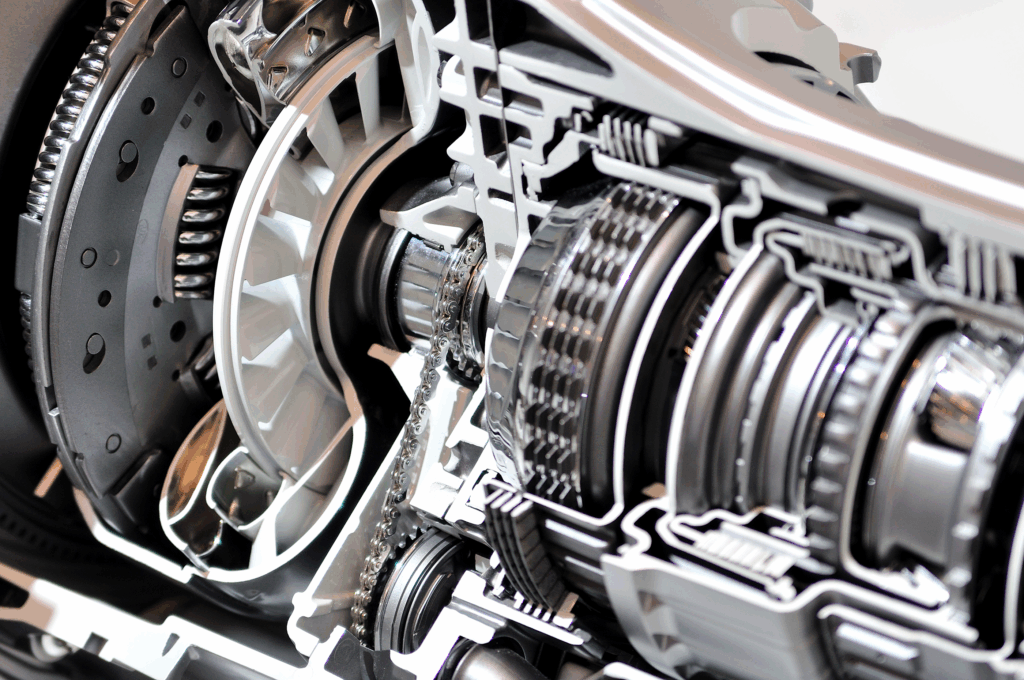
Transmission problems are the biggest headaches hyundai common problems UAE drivers face. These issues affect both driveability and safety in the region’s harsh climate. What starts as a minor problem can get worse faster and lead to serious mechanical failure.
Problem overview
The transmission slips and hesitates, which shows up as delayed engagement during acceleration from a stop or unexpected gear changes. Drivers notice these common symptoms:
- Rough or jerky shifting, especially from first to second gear
- Engine revs higher than normal before changing gears
- Vehicle hesitates or struggles with smooth acceleration
- Strange noises like grinding or whining during shifts
Hyundai vehicles with dual-clutch transmission (DCT) systems face these problems because of transmission clutch application logic failures. The transmission might not engage properly or move forward if you keep pressing the accelerator pedal. The UAE’s extreme heat makes things worse and causes the dual-clutch system to overheat faster.
Affected Hyundai models
We tested models with Hyundai’s 8-speed dual-clutch transmission (DCT). These include:
- 2021-2022 Santa Fe
- 2021-2022 Sonata
- 2021-2022 Veloster N
- 2022 Santa Cruz
- 2022 Elantra N
- 2022 Kona N
Hyundai Accent and Tucson owners with six-speed automatic transmissions report similar problems.
Repair cost or fix
Dealers usually reprogram the transmission control unit (TCU) with updated software that gives proper “fail-safe” driving capability. They also check the transmission and replace it if needed. Safety Recall 236 covers these repairs at no cost to owners.
Fix times depend on the problem—TCU reprogramming takes under an hour, while full transmission replacement needs much more time. Without warranty coverage, transmission repairs cost from AED 1,000 for minor fixes to AED 5,000 for major work. Full replacement can cost between AED 10,000-20,000.
Owner experiences
“My 2016 Hyundai Elantra’s first gear seems to slip until it shifts into second gear. All the corresponding gears work excellent with zero slippage,” reports one UAE owner.
UAE Hyundai owners say transmission problems get worse during summer months when temperatures exceed 40°C. Many lose forward momentum at traffic lights—this creates dangerous situations on Dubai’s busy roads.
ABS Module Fire Risk

The most important hyundai common problems UAE owners face is the ABS module fire risk. This life-threatening issue needs immediate attention, whatever the vehicle’s age or condition.
Problem overview
The Anti-Lock Brake System (ABS) module in these Hyundai vehicles has a critical design flaw. The system stays powered even after you turn off the ignition. This creates a dangerous situation where moisture can enter the electrical circuit and cause a short circuit. The electrical short gets more and thus encourages more current in the ABS module. This is a big deal as it means that the risk of an engine fire goes up – not just while driving but also in parked, unattended vehicles.
UAE drivers should know that this fire risk exists even if the brake system works fine. In fact, the National Highway Traffic Safety Administration has found that these electrical shorts can start fires in cars that have been parked for long periods.
Affected Hyundai models
The recall includes these Hyundai vehicles made between 2007-2015:
| 2007-2010 | Hyundai Elantra |
| 2009-2011 | Elantra Touring |
| 2007-2008 | Entourage |
| 2007 Santa Fe | |
| 2010-2013 | Tucson |
| 2013-2015 | Santa Fe Sport |
| 2012-2015 | Accent, Azera, and Veloster |
Repair cost or fix
Hyundai’s solution is to install a relay in the car’s main junction box. This cuts power to the ABS module when you turn off the vehicle, which stops potential electrical shorts. Authorized Hyundai service centers across the UAE do these repairs at NO CHARGE to owners.
Cars outside warranty with damaged ABS modules cost between AED 900 to AED 2000 to fix, depending on model and specs.
Owner experiences
“My mom’s 2013 Hyundai Accent just spontaneously combusted downtown while my sister and niece were driving it,” reports one owner, showing how unpredictable this defect can be.
A UAE owner shared their frustration after getting the recall notice: “I’m tired of waiting… My wife won’t let me park in the garage, sigh. Yadda yadda below the children’s bedrooms”.
Many owners now take extreme steps. Some disconnect their car batteries when parked or keep calling dealers for updates. All the same, Hyundai has been slow to provide rental vehicles. This adds to UAE owners’ worries, especially since the region’s high temperatures might speed up electrical component wear.
Electrical System Failures

Electrical systems act as the nervous system in today’s Hyundai vehicles, yet they remain one of the most common hyundai common problems UAE drivers face. The Emirates’ extreme heat and dust conditions make these problems more frequent compared to other regions.
Problem overview
Hyundai vehicles’ electrical failures show multiple symptoms including:
- Dimming or flickering headlights and dashboard lights
- Power windows and accessories operating intermittently
- Clicking sounds when attempting to start the engine
- Complete failure of instrument panels or infotainment systems
- Warning lights illuminating without apparent cause
Faulty alternators, battery problems, damaged electrical wiring, blown fuses, and malfunctioning sensors are the main causes behind these hyundai common issues. Rodents sometimes chew through the insulation of soy-based wire coatings, which leads to shorts. The UAE’s hot climate speeds up electrical component degradation, especially at connection points and control modules.
Affected Hyundai models
Service records and owner complaints show these electrical failures commonly affect:
- 2022-2024 Ioniq 5
- 2023-2025 Ioniq 6
- 2023-2025 Genesis GV60, GV70, GV80
- 2023-2024 Genesis G80
- 2017-2020 Santa Fe
- 2013-2018 Elantra
- 2016-2020 Tucson
Hyundai has recalled about 145,235 electrified vehicles in the US due to integrated charging control units (ICCU) failing to charge the 12-volt auxiliary battery properly.
Repair cost or fix
UAE service centers charge AED 300-500 for diagnosis, while total repair costs vary by issue:
- Battery replacement: AED 500-1,000
- Alternator repair/replacement: AED 800-2,000
- Wiring harness repairs: AED 600-1,500
- Control module replacement: AED 2,000-5,000
Many electrical repairs fall under warranty coverage, so owners should verify their warranty status before paying for repairs.
Owner experiences
“My 2020 Tucson’s electrical system completely shut down while driving in Dubai traffic,” reports one UAE owner. “The dashboard went dark and the car lost power steering, making it nearly impossible to safely navigate to the roadside”.
Newer models with sophisticated electronics tend to experience battery drain issues, even while parked.
Excessive Oil Consumption

Your Hyundai’s engine burning through oil without visible leaks is one of the biggest problems UAE drivers face. This hidden issue can destroy your engine if left unchecked.
Problem overview
Excessive oil consumption happens when engines burn oil at an unusual rate without external leaks. Hyundai vehicle owners report losing up to 1 quart of oil every 800-1,000 miles. Some owners found their engines completely dry after just 2,000 miles. Bad piston rings, worn engine parts, or design flaws let oil slip into the combustion chamber and burn with fuel.
You’ll notice these warning signs:
- Blue smoke from the exhaust
- Need to add oil often
- Check engine light comes on
- Engine doesn’t perform well
- Damage to catalytic converter
Affected Hyundai models
Class action lawsuits and service records show these models often have oil consumption problems:
- 2011-2014 Hyundai Sonata
- 2012-2020 Hyundai Elantra
- 2013-2016 Hyundai Tucson
- 2013-2016 Hyundai Santa Fe
- 2015-2021 Hyundai Sonata Hybrid
Nu, Gamma, Theta, Lambda, and Kappa engines are most likely to have this issue.
Repair cost or fix
A complete engine replacement costs about AED 29,375. First owners might get this covered under warranty. Second owners don’t get the same 10-year, 100,000-mile warranty protection.
Cars with this problem need constant monitoring. Owners must add oil every 800-1,000 miles if they can’t replace the engine.
Owner experiences
“There’s no oil in the car,” said a UAE resident about his 2017 Santa Fe. His engine had used all its oil after 2,000 miles, even though it passed a full inspection at 90,000 miles.
One owner lost a quart of oil every 500 miles. The problem got so bad that both engine and catalytic converter needed replacement because oil clogged the converter.
Hyundai dealers don’t deal very well with this issue. They often refuse warranty coverage to second owners, which frustrates many customers.
Engine Knocking and Seizing (Theta II Engine)

The Theta II engine controversy stands as one of the most systemic hyundai common problems UAE owners face, with implications way beyond the reach and influence of minor performance issues.
Problem overview
A distinct knocking noise marks the start of Theta II engine failure that gets louder as engine RPM increases. Metallic debris from manufacturing remained in the engine crankshaft. This contamination ended up restricting oil flow to connecting rod bearings and caused premature wear. The bearings’ deterioration leads to power loss, hesitation, vibration, and warning lights on the dashboard—especially check engine and oil pressure warnings.
Connecting rods can break and damage the engine block in severe cases. This allows oil to escape and touch hot surfaces that could start fires. Hyundai later admitted these failures came from four major design flaws they tried to hide, not just manufacturing debris.
Affected Hyundai models
These models came with problematic 2.0L and 2.4L Theta II engines:
- 2011-2019 Sonata
- 2013-2019 Santa Fe Sport
- 2014-2015 and 2018-2019 Tucson
- 2011-2013 Sonata Hybrid
- 2012-2017 Veloster
Repair cost or fix
Hyundai responded to massive warranty claims and legal pressure with several solutions:
- Lifetime warranties for affected engines
- Knock Sensor Detection System (KSDS) software update
- Complete engine replacements as needed
Engine replacement costs range from AED 15,000-29,000 without warranty coverage. UAE owners benefit from KSDS software that monitors engine vibrations to detect problems before total failure. The system activates a protective mode that limits speed to about 1,800-2,000 RPM if it finds issues.
Owner experiences
“This was the third engine failure for this vehicle and the last. I am not going to go through this again,” said one frustrated owner. A UAE resident’s 2013 Sorento engine failed without warning while crossing railroad tracks, which resulted in a serious accident.
Many UAE owners feel frustrated by Hyundai’s original response to acknowledge these problems. The company sometimes blamed customers for “not warming up the engine properly” or poor maintenance.
Airbag and Seatbelt Sensor Malfunctions
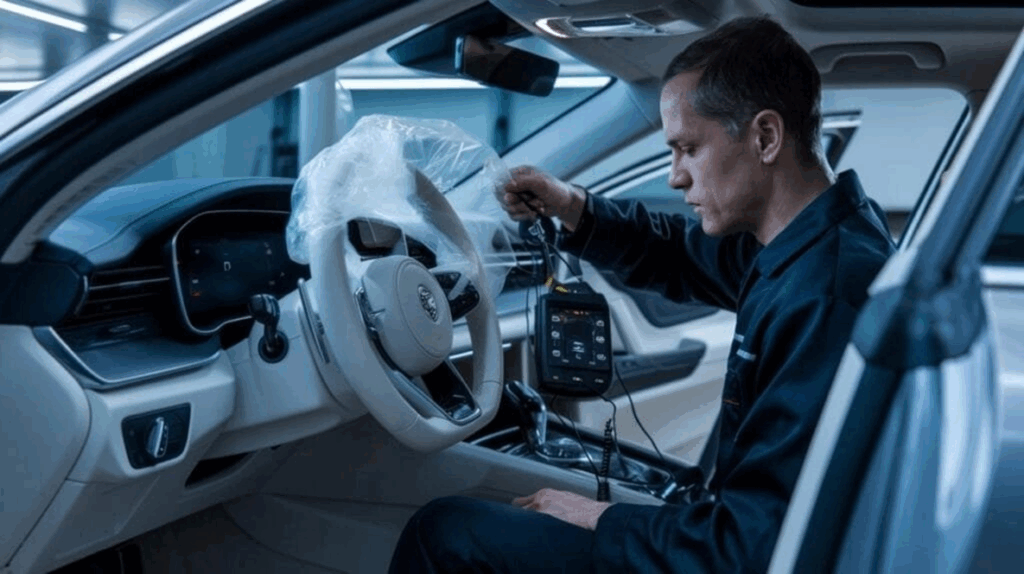
“Higher trims also offer advanced safety features like forward collision warning and automatic emergency braking, ensuring peace of mind for drivers and passengers alike.” — Arab Wheels Editorial Team, Automotive publication focusing on the Middle Eastern market
Safety system failures in Hyundai vehicles worry UAE owners. These malfunctions put occupant safety at risk during accidents.
Problem overview
Airbag and seatbelt sensors fail in several dangerous ways. The airbags don’t deploy during collisions, which leaves passengers vulnerable to injuries. The seat belts can unlatch without warning and completely remove restraint protection. Some pre-positioners behave abnormally during impacts and send metal fragments flying inside the passenger cabin. The warning lights and false warning chimes make it hard for drivers to know if their safety systems work properly.
Affected Hyundai models
Recent investigations show these problems in several Hyundai vehicles:
- 2020-2023 Palisade SUVs (approximately 332,288 vehicles)
- 2011-2014 Sonata and 2011-2015 Sonata Hybrid (977,778 vehicles)
- 2004-2006 Elantra models with front airbag failures
- 2024 Santa Fe and hybrid Santa Fe models (nearly 50,000 vehicles)
- 2019-2022 Elantra and Accent (exploding seat belt pre-positioners)
Repair cost or fix
Each malfunction needs different solutions. A complete seat belt assembly replacement costs between AED 1101.58- 1468.78. Vehicles under active recall get free repairs at authorized dealerships. Specialists use OBD-II scanners to read error codes and reset the system after repairs. Some fixes need new sensors, wiring harnesses, or entire control units.
Owner experiences
“My mom’s car just spontaneously combusted downtown while my sister and niece were driving it,” one owner said about their faulty restraint system. A Creta owner received compensation when airbags failed during a frontal collision. The situation became serious when four deaths and six injuries were linked to airbag failures in specific Hyundai models. Owners find it hard to diagnose problems because warning lights flash randomly.
Infotainment System Glitches

Modern infotainment systems have become the technological pain point for hyundai common problems UAE drivers report. These issues create frustrations beyond mere inconvenience and can lead to dangerous driving distractions.
Problem overview
Hyundai vehicles’ infotainment system glitches show up in several ways that disrupt your driving experience. These problems include:
- Touchscreen not responding or having calibration issues
- Display flickering or showing blank screens
- Software update failures during installation
- Connectivity problems with Bluetooth and smartphone integration
- System freezes that need reboots
- Navigation errors with wrong locations
- Reverse camera display problems that compromise safety
These hyundai common issues become worse in UAE’s extreme temperatures. The infotainment systems often become less responsive or stop working during summer months. J.D. Power’s Multimedia Quality survey shows that infotainment systems make up 25% of all multimedia problems. Connectivity issues rank as the top complaint.
Affected Hyundai models
Repair records and customer complaints show these infotainment glitches affect:
- 2020-2023 Hyundai Palisade (especially when you have larger screens)
- 2021-2022 Hyundai Tucson
- 2020-2022 Hyundai Elantra
- 2021-2023 IONIQ 5 (the first model with OTA functionality)
- 2022-2025 Hyundai Sonata
Repair cost or fix
Hyundai offers several solutions for software-related issues:
Newer models like IONIQ 5 can get automatic software fixes through over-the-air (OTA) updates without dealership visits. Older models can get USB updates from Hyundai’s Navigation Update Portal.
Hardware replacement costs vary:
- Diagnosis fee: AED 149-300
- Screen replacement: AED 900-4,600 based on model
- Navigation system repair: AED 1,000-2,500
- Complete head unit replacement: Around AED 13,219 for Palisade models
Owner experiences
“My wife is experiencing screen problems. Rear camera not stopping when driving forward, screen going blank and coming back on,” a UAE Venue owner shares.
A Palisade owner explains: “The issue is that certain buttons stop working. Mostly the steering wheel audio control buttons. When this happens the map also becomes very slow to pop up after original start up”.
Many owners have found a temporary fix using the reset button (near setup or volume controls). This performs a soft reboot without erasing personal settings. Most owners need to do this reset several times each month.
Fuel Gage Sensor Failure

Faulty fuel gage readings pose a serious risk for hyundai common problems UAE drivers face. These issues can leave drivers stranded with empty tanks even when their indicators show plenty of fuel.
Problem overview
Your fuel gage sensor (or sending unit) relies on a float mechanism to measure fuel levels and send this information to your dashboard. A failing component can cause your gage to show wrong readings, stick at full or empty, jump around randomly, or display incorrect levels while you drive.
The malfunction happens due to several reasons:
- Corrosion and excessive vibration damage the sensor
- Electrical and wiring problems disrupt signals
- Internal circuits in the fuel sender unit fail
- Dirt or sediment buildup interferes with the float arm
The UAE’s harsh temperatures make these components deteriorate faster, which explains why this problem occurs more often in this region.
Affected Hyundai models
This hyundai common issue affects many models:
- 2012-2015 Tucson
- 2016 Elantra
- 2022 Elantra SEL
- 2021-2022 Tucson (digital dash models)
- Santa Fe owners report similar issues
Repair cost or fix
The solution remains straightforward despite the complex nature of the problem:
- Fuel gage sensor replacement: AED 917.99 to AED 2,937.55
- Labor costs: AED 514.07 to AED 991.42
- Parts cost: AED 458.99 to AED 734.39
Simple issues might resolve by disconnecting the battery for 10 minutes to reset the fuel gage system.
Owner experiences
“My gas gage is not working properly, I reset my trip gage and figure out when it’s time to gas up according to the mileage,” reports one 2012 Tucson owner who found that there was “a constant problem with Hyundais” according to gas station attendants.
Another owner of a 2021 Elantra noted: “It flies through that first quarter but then evens out. Just manually keep track of your gas mileage and you’ll see it’s fine”.
UAE drivers now commonly track their mileage manually to work around this persistent hyundai cars common problem.
Suspension Wear and Tear

Suspension problems are a critical yet overlooked category of hyundai common problems UAE drivers face. The region’s road conditions magnify wear patterns beyond manufacturer expectations.
Problem overview
Shock absorbers play a crucial role in vehicle performance and safety. These components ensure proper tire contact with the road, distribute the car’s weight evenly, and deliver comfortable ride quality. Several hyundai common issues can plague the suspension system:
- Unusual noises (clunking, squeaking, whistling) over bumps
- Instability in driving behavior and excessive body roll
- Changes in vehicle body height (one corner lower than others)
- Pulling to one side while driving
- Excessive bouncing or dipping on uneven surfaces
- Rough or uncomfortable ride quality
Hyundai shock absorbers last about 80,000 kilometers under normal conditions. UAE’s extreme heat and uneven road surfaces speed up deterioration, which leads to frequent premature failures.
Affected Hyundai models
This hyundai cars common problem affects models of all sizes:
- 2020-2021 Palisade with rear self-leveling shocks (covered under TSB 22-SS-001H)
- 2020-2023 Santa Fe (especially with self-leveling suspension)
- Hyundai i20 Elite (multiple model years)
- 2013-2018 Tucson
Repair cost or fix
Repair costs depend on the severity and affected components:
- Complete shock absorber replacement: AED 1,000-2,500 for parts and labor
- Suspension bushings replacement: AED 600-800
- Full suspension overhaul: AED 2,500-5,000 depending on model
Palisade owners who experience knocking sounds can get their rear shocks replaced under warranty at dealerships. i20 model owners can sometimes fix squeaking suspension through proper component lubrication.
Owner experiences
“I would describe it as a single knocking or popping sound. In my case, it seems to come from the back left, and happens when turning, accelerating, removing my foot from the accelerator,” reports one 2020 Palisade owner.
A UAE resident with a 2020 Santa Fe Premium described the suspension as “crazy hard, almost undrivable.” Later diagnosis revealed “frozen and seized rear shocks” that needed AED 2,500 in warranty repairs.
Dealer diagnostics frustrate many Hyundai owners. One customer spent “4 and a half hours at a dealership for them to do a visual inspection that probably took 5 minutes”.
Hydraulic Electronic Control Unit Short

Fire hazards caused by electrical shorts in Hyundai vehicles are among the most dangerous hyundai common problems UAE drivers should know about right away. The Hydraulic Electronic Control Unit (HECU) malfunction is particularly concerning because of what it all means.
Problem overview
The HECU plays a vital role in the anti-lock braking system. A design flaw allows moisture or brake fluid to seep into electronic circuits and cause dangerous electrical shorts. These shorts can start engine compartment fires that happen
while driving and even when the vehicle is parked and turned off. The root causes are straightforward:
- Faulty seals let external moisture enter the module
- Manufacturing errors by suppliers lead to internal brake fluid leaks from the ABS module
The module stays powered after you turn off the ignition, which creates ongoing fire risks whatever the vehicle’s operating status.
Affected Hyundai models
The HECU problem shows up in several Hyundai vehicles:
- 2016-2018 Santa Fe
- 2017-2018 Santa Fe Sport
- 2019 Santa Fe XL
- 2014-2015 Tucson
- 2021-2022 Tucson
Some Kia models that use the same components as Hyundai face similar issues. A single recall covered about 484,000 vehicles.
Repair cost or fix
Hyundai provides these solutions:
- Free installation of a new HECU circuit board fuse under recall
- A lower amperage ABS multi-fuse replacement
- Full inspection and ABS module replacement if needed
ABS module replacement costs range from AED 900-2,000 for vehicles without warranty coverage, depending on model specs.
Owner experiences
“My wife won’t let me park in the garage… below the children’s bedrooms,” one worried owner said. Hyundai told owners they should park their vehicles “outdoors and away from structures” until repairs were complete.
The National Highway Traffic Safety Administration (NHTSA) looked into Hyundai’s recall fixes. This led to a settlement worth about AED 1101.58 million that covered affected owners.
Ignition Coil and Spark Plug Issues

Ignition components serve as crucial performance boosters in your vehicle. These parts often show up in hyundai common problems UAE reports whenever owners face sudden engine troubles or stalling.
Problem overview
Ignition coils convert your battery’s basic 12 volts into thousands of volts that spark plugs need to ignite the fuel-air mixture. Your car will show several warning signs as these parts wear down: poor fuel economy, engine misfires, starting problems, stalling, and check engine warnings. A sluggish or rough-running engine with strange vibrations remains the most common symptom.
Your ignition system fails mainly because of moisture, heat, engine vibrations, and worn spark plugs. These components break down faster in UAE’s harsh climate. Heat stress damages the internal insulation substantially.
Affected Hyundai models
These Hyundai models report ignition coil or spark plug problems:
- 2011-2017 Accent models
- 2013-2014 Elantra Coupe
- 2020-2021 Venue
- 2015-2019 Sonata
- 2011-2012 Genesis Coupe
- 2018-2022 Kona
The Accent’s 1.6-liter engine shows more problems with ignition system failures.
Repair cost or fix
Parts for ignition coil replacement cost between AED 146.88 and AED 1101.58. Labor costs depend on your engine’s design and how easy it is to reach the coils. Spark plugs cost less to replace but need changing every 35,000-60,000 miles based on how you drive.
Handy car owners can replace a coil in about 30 minutes. Hyundai suggests checking spark plugs after 30,000 miles (50,000 km) even if everything seems fine.
Owner experiences
“My wife is experiencing engine problems. When this happens, acceleration becomes very slow to respond after original start up,” reports one UAE Hyundai owner. Another owner found their ignition problems after noticing “engine misfires and rough idling that worsened in summer months”.
One Elantra owner shared: “I changed the ignition coils to fix an issue when it rains and WOW! I didn’t realize my car was running rough until it wasn’t. Idling, acceleration and shifting are all substantially smoother”.
Without doubt, many owners fix these problems by replacing parts quickly and save themselves from bigger engine damage that could develop later.
Battery Drain and Charging Problems
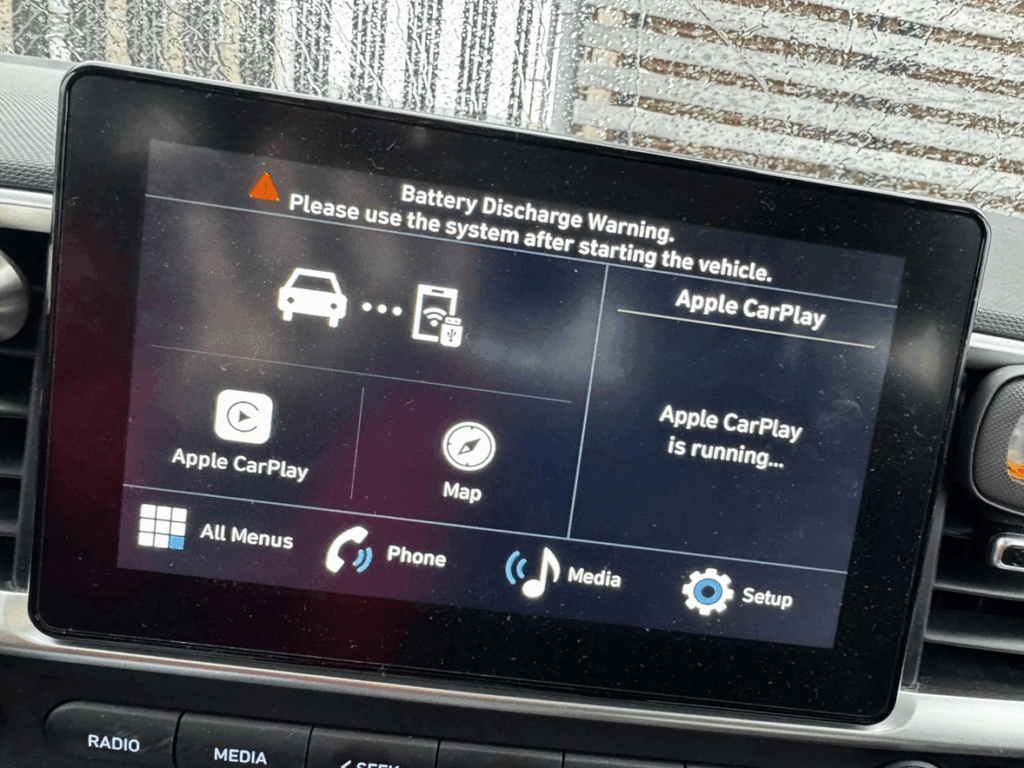
Battery problems are among the most frustrating hyundai common problems UAE drivers encounter. These issues can leave owners stranded without warning in the harsh desert climate.
Problem overview
Hyundai vehicles often face battery drain when left unused for long periods. This is a common issue for UAE residents who travel during summer. Dead batteries can result from electronics left running, short trips that don’t allow full charging, and the extreme temperatures that wear down batteries faster. Some owners have found their batteries dead after just 10-15 days without use.
The problem extends to Hyundai’s electric vehicles and their 12V batteries. The Integrated Charging Control Unit (ICCU) can malfunction and stop the main high-voltage battery from charging the 12V auxiliary battery. This leads to complete system failure. Owners must then use manual keys to enter their vehicles and need jump-starts to get going again.
Affected Hyundai models
These battery problems show up most in:
- 2022-2024 Ioniq 5
- 2023-2025 Ioniq 6
- 2023-2025 Genesis GV60, GV70, and G80
- Hyundai Creta (multiple reports)
- Hyundai Kona Electric
- Standard models like Sonata and Tucson
Repair cost or fix
UAE battery prices vary based on type:
- Standard lead-acid batteries cost between AED 139-500
- AGM batteries for newer models range from AED 400-1,000
- High-end batteries for performance vehicles can reach AED 2,000
Mobile battery services in Dubai, Sharjah, and Abu Dhabi can replace batteries in 15-20 minutes. They offer warranties up to 18 months. A quick fix involves driving for at least 20 minutes after a jump-start to recharge the battery. It’s worth checking any aftermarket electronics that might drain power.
Owner experiences
“I have left my 2024 Hyundai Kona Electric for almost a month when I was traveling. No problems when I got home,” one owner shares. Another owner’s story differs – their Creta’s battery died twice in three months despite minimal use.
Many owners feel frustrated when Hyundai service centers tell them battery drain is “normal” after 15 days without use. Some have turned to trickle chargers or solar maintainers as prevention. They believe this points to a design flaw rather than user error.
Comparison Table
| Problem | Affected Models | Main Symptoms | Typical Repair Cost (AED) | Primary Causes |
| Engine Crankshaft Sensor Failure | 2011-2014 Sonata, 2013- 2014 Santa Fe Sport | Hard to start, stalls, weak acceleration | 400-1,200 | Sensor degradation, weather sensitivity |
| Transmission Slipping | 2021-2022 Santa Fe, Sonata, Veloster N | Harsh shifts, slow engagement, hesitation | 1,000-20,000 | DCT system issues, overheating |
| ABS Module Fire Risk | 2007-2015 Elantra, Tucson, Santa Fe | Fire hazard in parked state, electrical shorts | 900-2,000 | Moisture entering electrical circuit |
| Electrical System Failures | 2022-2024 Ioniq 5, 2023- 2025 Genesis models | Lights dim, accessories work intermittently | 500-5,000 | Heat damage, wiring issues |
| Excessive Oil Consumption | 2011-2014 Sonata, 2012- 2020 Elantra | Blue smoke, needs frequent oil additions | 29,375 (engine replacement) | Faulty piston rings, worn components |
| Theta II Engine Issues | 2011-2019 Sonata, 2013- 2019 Santa Fe Sport | Knocking sounds, power loss, engine seizure | 15,000-29,000 | Manufacturing debris, design flaws |
| Airbag/Seatbelt Sensors | 2020-2023 Palisade, 2011- 2014 Sonata | Warning indicators, failed deployments | 1,101-1,468 | Electrical issues, sensor malfunctions |
| Infotainment Glitches | 2020-2023 Palisade, 2021- 2022 Tucson | Screen locks up, connection problems | 900-13,219 | Software bugs, heat sensitivity |
| Fuel Gage Sensor | 2012-2015 Tucson, 2016 Elantra | Wrong readings, gage stops moving | 917-2,937 | Corrosion, electrical issues |
| Suspension Problems | 2020-2021 Palisade, 2020- 2023 Santa Fe | Strange noises, unstable ride, roughness | 1,000-5,000 | Heat damage, road conditions |
| HECU Short Circuit | 2016-2018 Santa Fe, 2014- 2015 Tucson | Fire risk, electrical shorts | 900-2,000 | Moisture intrusion, brake fluid leaks |
| Ignition Coil Issues | 2011-2017 Accent, 2013- 2014 Elantra | Engine misfires, runs rough, stalls | 146-1,101 | Heat stress, component wear |
| Battery Drain | 2022-2024 Ioniq 5, 2023- 2025 Ioniq 6 | Battery dies, charging fails | 139-2,000 | Climate conditions, parasitic drain |
Conclusion
Hyundai vehicles in the UAE face unique challenges due to the extreme climate. Problems range from minor issues to dangerous defects. Engine problems are the biggest concern, especially the Theta II engine failures and crankshaft sensor malfunctions that leave drivers stuck on the road. The ABS module fire risk and HECU shorts create real safety hazards. Transmission troubles and excessive oil consumption can get pricey – repairs can cost more than AED 20,000 in bad cases.
The UAE’s harsh climate makes these problems worse. High temperatures cause more electrical issues, infotainment glitches, and battery drain. Smart buyers should research specific model histories before purchase and focus on models that have fewer documented problems.
Hyundai owners need to check if their cars are part of any recall campaigns. These campaigns often fix serious defects for free. Regular maintenance is crucial. You’ll need more frequent fluid checks and early replacement of parts like ignition coils and crankshaft sensors.
These problems might look scary, but most are fixable with the right care. The comparison table helps you spot warning signs in your car before they turn into major failures. A good understanding of common Hyundai problems gives UAE drivers the knowledge to make smart choices about purchases and repairs. This knowledge helps you know when to use warranty coverage and can save thousands in surprise repair costs while keeping you safe on UAE roads.
FAQs
Q1. What is the most serious issue affecting Hyundai vehicles in the UAE?
The most concerning problems are engine-related, particularly Theta II engine failures and crankshaft sensor malfunctions that can leave drivers stranded. Additionally, the ABS module fire risk and HECU electrical shorts present significant safety hazards.
Q2. How does the UAE climate impact Hyundai vehicles?
The extreme heat in the UAE accelerates many issues, including electrical problems, infotainment system glitches, and battery drain. It also contributes to faster degradation of components like ignition coils and suspension parts.
Q3. What is the average lifespan of a Hyundai engine?
Typically, Hyundai engines can last about 200,000 miles with proper maintenance. However, some models may experience issues earlier, especially in harsh climates like the UAE.
Q4. Which Hyundai models are most reliable in UAE conditions?
While reliability can vary, models like the Azera (Hyundai’s flagship sedan in the UAE), Kona, and Santa Fe generally perform well. It’s important to research specific model years and their documented issues before purchasing.
Q5. How can Hyundai owners in the UAE prevent common problems?
Regular maintenance is crucial, including more frequent fluid checks and preventative replacement of vulnerable components. Owners should also check for recall campaigns, which often provide free repairs for serious defects, and consider using trickle chargers or solar maintainers to prevent battery drain during extended periods of inactivity.


